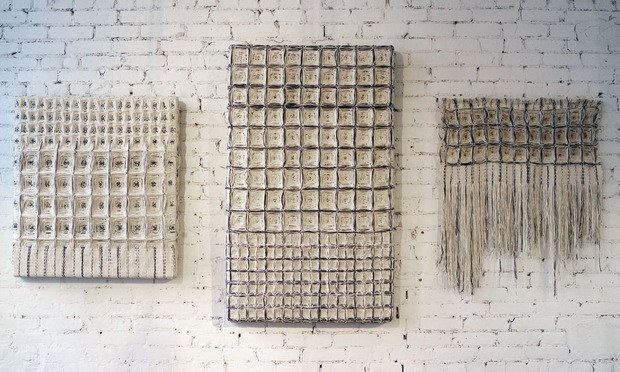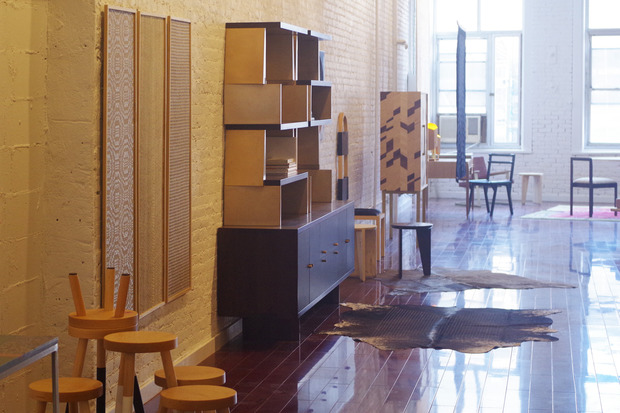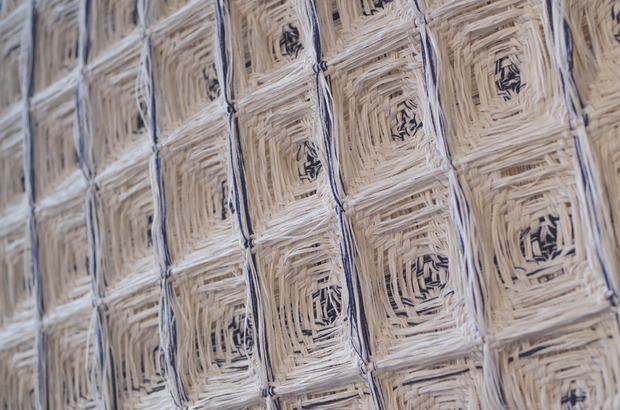Hiroko Takeda’s 3D Textiles
The Brooklyn artist’s structural woven works now on display at Colony co-op


Since 2010, Hiroko Takeda has helmed an eponymous design studio that produces artistically superior textiles for the home and beyond. More than just furnishings, her works are often stand-alone art pieces hailing from a rich imagination and desire to explore. While Takeda has predominantly specialized in site-specific works done in collaboration with architects and interior designers from around the globe, she’s also lent her talents to the fashion world.
Raised in Japan and trained in the tradition of the Mingei Undou, Takeda then received a masters in Constructed Textiles at the Royal College of Art in London. After working as the Senior Designer at the Jack Lenor Larsen Design Studio in New York and as a custom designer for Kawashima Textiles in Tokyo, she embarked on a quest of her own. Which, in short, has lead to her most recent showcase of work at NYC’s Colony, a co-op for designers founded by Jean Lin.

Opening yesterday, 26 June 2014, the Colony show puts multiple diverse textile works on show, adorning the walls among objects from lighting and furniture designers. Amongst so much of her work, we had the pleasure of speaking with Takeda about her process, inspirations and on the inception of the show. Of which, Takeda says she was first introduced to Lin at a textile trade show the year prior. “She had this idea of an independent, small design studio put together like a co-op, and she asked me if I wanted to be a part of it.” Takeda took the opportunity, using it as a showroom extension for her business.

While Takeda’s work is meticulously pieced together, she shies away from research to the nth degree, preferring rather to leave much of her work to experimentation, exploration and trial and error. “I do not think about what the fabric is for,” she shares. “I like weaving structure and experiments. I think about yarn. Some of the yarn is eight threads together, something I’ve done to create my own color.” This blending technique contributes to the works artistry and uniqueness. “I mix a lot to make them more like paintings,” she continues before addressing her structural balance—switching between experimental and traditional pieces, she notes that some are very much “nerdy structures” of which only weavers can truly grasp the intricacy.


Her more experimental works are best represented in her 3D honeycomb-style pieces—stand-alone artworks. “Textile designers don’t get to see an end product. We constantly do two dimensional work and never see the final result,” she says. It was the desire to complete a project—rather than an element of something greater—that inspired these works. “When I weave I get really excited. Why don’t I emphasize this more?” she wonders. Drawing inspiration from waffle patterns she had frequently observed in dish towels, and in other tiny forms of domestic use, she expanded the core concept. “I emphasized and enlarged the structure and used a lot of different yarn: silk, cotton, linen, indigo.” The result is a signature piece in the artists repertoire.

On the other end of the spectrum, Colony also showcases Takeda’s commercial textiles, crafted to be used in everything from draperies and bedspreads to wall panels. Many of these works feature metallic elements, but Takeda explains that it’s merely an illusion. “It’s not actual metal. It’s polyester and nylon mixed thread. I mix it all with linen. I like shine, but I like contrast as well. It’s a balance between dry and shine.” To a lesser degree, some of her commercial works also employ the waffle structure, while others veer in another direction entirely. And yet, across all of her work there is a voice—a signature of sorts—reflected in the use of color and pursuit of patterns. While her traditional background and extensive training are evident, there’s also a visible element of the uncommon.
Takeda’s work is now on show at Colony (324 Canal St, 2nd Floor, NYC).
Photos by David Graver












